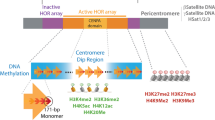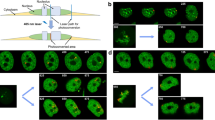Abstract
Mitotic and meiotic chromosomes of Tityus bahiensis were investigated using light (LM) and transmission electron microscopy (TEM) to determine the chromosomal characteristics and disclose the mechanisms responsible for intraspecific variability in chromosome number and for the presence of complex chromosome association during meiosis. This species is endemic to Brazilian fauna and belongs to the family Buthidae, which is considered phylogenetically basal within the order Scorpiones. In the sample examined, four sympatric and distinct diploid numbers were observed: 2n = 5, 2n = 6, 2n = 9, and 2 = 10. The origin of this remarkable chromosome variability was attributed to chromosome fissions and/or fusions, considering that the decrease in chromosome number was concomitant with the increase in chromosome size and vice versa. The LM and TEM analyses showed the presence of chromosomes without localised centromere, the lack of chiasmata and recombination nodules in male meiosis, and two nucleolar organiser regions carrier chromosomes. Furthermore, male prophase I cells revealed multivalent chromosome associations and/or unsynapsed or distinctly associated chromosome regions (gaps, less-condensed chromatin, or loop-like structure) that were continuous with synapsed chromosome segments. All these data permitted us to suggest that the chromosomal rearrangements of T. bahiensis occurred in a heterozygous state. A combination of various factors, such as correct disjunction and balanced segregation of the chromosomes involved in complex meiotic pairing, system of achiasmate meiosis, holocentric nature of the chromosomes, population structure, and species dispersion patterns, could have contributed to the high level of chromosome rearrangements present in T. bahiensis.









Similar content being viewed by others
Abbreviations
- CV:
-
Coefficient of variation
- DSL:
-
Diploid set length
- LM:
-
Light microscopy
- NOR:
-
Nucleolar organiser region
- PTA:
-
Phosphotungstic acid
- SC:
-
Synaptonemal complex
- TEM:
-
Transmission electron microscopy
References
Altiero T, Rebecchi L (2003) First evidence of achiasmatic male meiosis in the water bears Richtersius coronifer and Macrobius richtersi (Eutardigrada, Macrobiotidae). Hereditas 139:116–120
Benavente R (1982) Holocentric chromosomes of arachnids: presence of kinetochore plates during meiotic divisions. Genetica 59:23–27
Bloom WL (1974) Origin of reciprocal translocations and their effect in Clarkia speciosa. Chromosoma 49:61–76
Chinnappa CC, Victor R (1979) Achiasmatic meiosis and complex heterozygosity in female cyclopoid copepods (Copepoda, Crustacea). Chromosoma 71:227–236
da Silva CRM, González-Elizondo MS, Vanzela ALL (2008) Chromosome reduction in Eleocharis maculosa (Cyperaceae). Cytogenet Genome Res 122:175–180
Dernburg AF (2001) Here, there, and everywhere: kinetochore function on holocentric chromosomes. J Cell Biol 153:33–38
Fan Q, Yao M (1996) New telomere formation coupled with site-specific chromosome brakage in Tetrahymena thermophila. Mol Cell Biol 16:1267–1274
Forejt J, Gregorová S, Goetz P (1981) XY pair associates with synaptonemal complex of autosomal male-sterile translocations in pachytene spermatocytes of the mouse (Mus musculus). Chromosoma 82:41–53
Gassner G (1969) Synaptinemal complexes in the achiasmatic spermatogenesis of Bolbe nigra Giglio-Tos (Mantoidea). Chromosoma 26:22–34
Gomes FP (1982) Curso de estatística experimental, 10th edn. Nobel, São Paulo
Gorlov IP, Gorlova OY, Logunov DV (1995) Cytogenetic studies on Siberian spiders. Hereditas 122:211–220
Gupta AKD, Sarker SK (1965) A study of the meiotic chromosomes of the scorpion Buthus tamulus Fabr. Curr Sci 2:54–55
Howell WM, Black DA (1980) Controlled silver-staining of nucleolus organizer regions with a protective colloidal developer: a 1-step method. Experientia 36:1014–1015
Ituarte S, Papeschi AG (2004) Achiasmatic male meiosis in Tenagobia (Fuscagobia) fuscata (Stål) (Heteroptera, Corixoidea, Micronectidae). Genetica 122:199–206
James SH (1970) Complex hybridity in Isotoma petraea. II. Components and operation of a possible evolutionary mechanism. Heredity 25:53–77
John B (1990) Meiosis. Cambridge University Press, Melbourn
John B, Lewis KR (1958) Studies on Periplaneta americana. III. Selection for heterozygosity. Heredity 12:185–197
John B, Quraishi HB (1964) Studies on Periplaneta americana. IV. Pakistani populations. Heredity 19:147–156
Kingswood SC, Kumamoto AT, Sudman PD, Fletcher KC, Greenbaum IF (1994) Meiosis in chromosomally heteromorphic goitered gazelle, Gazella subgutturosa (Artiodactyla, Bovidae). Chromosome Res 2:37–46
Kodama Y, Yoshida MC, Sasaki M (1980) An improved silver staining technique for nucleolus organizer regions by using nylon cloth. Jpn J Hum Genet 25:229–233
Král J, Musilová J, Št’áhlavský F, Řezáč M, Akan Z, Edwards RL, Coyle FA, Almerje CR (2006) Evolution of the karyotype and sex chromosome systems in basal clades of araneomorph spiders (Araneae: Araneomorphae). Chromosome Res 14:859–880
Lawrence CW (1958) Genotypic control of chromosome behaviour in rye. VI. Selection for disjunction frequency. Heredity 12:127–131
Lawrence CW (1963) The orientation of multiple associations resulting from interchange heterozygosity. Genetics 48:347–350
Loidl J, Jones GH (1986) Synaptonemal complex spreading in Allium. I. Triploid A. sphaerocephalon. Chromosoma 93:420–428
Luceño M, Guerra M (1996) Numerical variations in species exhibiting holocentric chromosomes: a nomenclatural proposal. Caryologia 49:301–309
Marec F, Traut W (1993) Synaptonemal complexes in female and male meiotic prophase of Ephestia kuehniella (Lepidoptera). Heredity 73:394–404
Moore G, Aragón-Alcaide L, Roberts M, Reader S, Miller T, Foote T (1997) Are rice chromosomes components of a holocentric chromosome ancestor? Plant Mol Biol 35:17–23
Moustafa MA, Alaa AM, Sarlan MH, Yaseen AE (2005) Chromosomal studies on four Egyptian scorpion species of genus Androctonus (Family: Buthidae). Cytologia 70:161–165
Nagaki K, Kashihara K, Murata M (2005) Visualization of diffuse centromeres with centromere-specific histone H3 in the holocentric plant Luzula nivea. Plant Cell 17:1886–1893
Piza ST (1943) A propósito da meiose do Tityus bahiensis. Rev Agric 18:351–369
Piza ST (1947a) Notas sôbre cromossômios de alguns escorpiões brasileiros. An Esc Super Agric Luiz de Queiroz 60:169–176
Piza ST (1947b) Uma raça cromossômica natural de Tityus bahiensis (Scorpiones-Buthidae). An Esc Super Agric Luiz de Queiroz 62:183–192
Piza ST (1948a) Primeiras observações sôbre os cromossômios de Tityus trivittatus Krpln (Scorpiones – Buthidae). Rev Agric 24:177–180
Piza ST (1948b) Uma nova raça cromossômica natural de Tityus bahiensis (Scorpiones, Buthidae). Rev Agric 24:181–186
Piza ST (1948c) Variações cromossômicas do Tityus bahiensis de São Joaquim. Rev Agric 24:187–194
Piza ST (1949) “Ouro Preto”, nova e interessante raça cromossômica de Tityus bahiensis (Scorpiones – Buthidae). Sci Genet 3:147–159
Piza ST (1950) Observações cromossômicas em escorpiões brasileiros. Cienc Cult 2:202–206
Piza ST (1957) The chromosomes of Rhopalurus (Scorpiones – Buthidae). Can Entomol 89:565–568
Polis GA (1990) Ecology. In: Polis GA (ed) The biology of scorpions. Stanford University Press, Stanford, pp 247–293
Procunier WS (1975) A cytological study of two closely related blackfly species: Cnephia dacotensis and Cnephia ornithophilia (Diptera: Simulidae). Can J Zool 53:1622–1637
Rasmussen SW (1977) Meiosis in Bombyx mori females. Philos Trans R Soc Lond B Biol Sci 277:343–350
Reed KM, Sites JW Jr, Greenbaum IF (1992) Synapsis, recombination, and meiotic segregation in the mesquite lizard, Sceloporus grammicus, complex. I. Pericentric inversion heteromorphism of the F5 cytotype. Cytogenet Cell Genet 61:40–45
Rodríguez Gil SG, Mola LM, Papeschi AG, Scioscia CL (2002) Cytogenetic heterogeneity in common haplogyne spiders from Argentina (Arachnida, Araneae). J Arachnol 30:47–56
Schneider MC, Zacaro AA, Pinto-da-Rocha R, Candido DM, Cella DM (2009) A comparative cytogenetic analysis of two Bothriuridae species and overview of the chromosome data of Scorpiones. J Heredity 100(5):545–555. doi:10.1093/jhered/esp023
Serrano J (1981) Male achiasmatic meiosis in Caraboidea (Coleoptera, Adephaga). Genetica 57:131–137
Shanahan CM (1989a) Cytogenetics of Australian scorpions. I. Interchange polymorphism in the family Buthidae. Genome 32:882–889
Shanahan CM (1989b) Cytogenetics of Australian scorpions. II. Chromosome polymorphism in species of Urodacus (family Scorpionidae). Genome 32:890–900
Shanahan CM, Hayman DL (1990) Synaptonemal complex formation in male scorpions exhibiting achiasmate meiosis and structural heterozygosity. Genome 33:914–926
Sharma GP, Parshad R, Joneja MG (1959) Chromosome mechanism in the males of three species of scorpions (Scorpiones – Buthidae). Res Bull Panjab Univ Sci 10:197–207
Slijepcevic P, Xiao Y, Natarajan AT, Bryant PE (1997) Instability of CHO chromosomes containing interstitial telomeric sequences originating from Chinese hamster chromosome 10. Cytogenet Cell Genet 76:58–60
Solari AJ, Counce SJ (1977) Synaptonemal complex karyotyping in Melanoplus differentialis. J Cell Sci 26:229–250
Soleglad ME, Fet V (2003) High-level systematics and phylogeny of the extant scorpions (Scorpiones: Orthosterni). Euscorpius 11:1–175
Šťáhlavský F, Král J (2004) Karyotype analysis and achiasmatic meiosis in pseudoscorpions of the family Chthoniidae (Arachnida: Pseudoscorpiones). Hereditas 140:49–60
Sumner AT (1972) A simple technique for demonstrating centromeric heterochromatin. Exp Cell Res 75:304–306
Sun S, Rees H (1967) Genotypic control of chromosome behaviour in rye. IX. The effect of selection on the disjunction frequency of interchange associations. Heredity 22:249–254
Suomalainen E (1966) Achiasmatische oogenese bei trichopteran. Chromosoma 18:201–207
Takahashi CS (1976) Cytogenetical studies on the effects of high natural radiation levels in Tityus bahiensis (Scorpiones, Buthidae) from Morro do Ferro, Brazil. Radiat Res 67:371–381
Thompson JB (1956) Genotypic control of chromosome behaviour in rye. II. Disjunction at meiosis in interchange heterozygotes. Heredity 10:99–108
Traut W, Clarke CA (1996) Cytogenetics of a moth species with a low chromosome number, Orgyia thyellina. Hereditas 125:277–283
Vítková M, Král J, Traut W, Zrzavý J, Marec F (2005) The evolutionary origin of insect telomeric repeats, (TTAGG)n. Chromosome Res 13:145–156
White MJD (1973) Animal cytology and evolution, 3rd edn. Cambridge University Press, London
Wolf KW (1996) The structure of condensed chromosomes in mitosis and meiosis of insects. Int J Insect Morphol Embryol 25:37–62
Wrensch DL, Kethley JB, Norton RA (1994) Cytogenetics of holokinetic chromosomes and inverted meiosis: keys to the evolutionary success of mites, with generalizations on eukaryotes. In: Houck MA (ed) Mites: ecological and evolutionary analyses of life-history patterns. Chapman & Hall, London, pp 282–343
Zetka MC, Müller F (1996) Telomeres in nematodes. Semin Cell Dev Biol 7:59–64
Acknowledgements
We are indebted to two anonymous reviewers for critical reading and valuable suggestions for the manuscript. The authors are also grateful to the Centro de Controle de Zoonoses, from Piracicaba, SP, Brazil, for collecting T. bahiensis. Furthermore, we would like to thank Dr. Flávio H. Caetano and Antonio T. Yabuki, both from the Centro de Microscopia Eletrônica, Departamento de Biologia, Instituto de Biociências, UNESP, Rio Claro, SP, Brazil, for providing access to the infrastructure required for ultrastructural analysis and for technical assistance, respectively. This research was supported by the Fundação de Amparo à Pesquisa do Estado de São Paulo, FAPESP (06/53275-3).
Author information
Authors and Affiliations
Corresponding author
Additional information
Responsible Editor: Walther Traut.
Rights and permissions
About this article
Cite this article
Schneider, M.C., Zacaro, A.A., Pinto-da-Rocha, R. et al. Complex meiotic configuration of the holocentric chromosomes: the intriguing case of the scorpion Tityus bahiensis . Chromosome Res 17, 883–898 (2009). https://doi.org/10.1007/s10577-009-9076-4
Received:
Revised:
Accepted:
Published:
Issue Date:
DOI: https://doi.org/10.1007/s10577-009-9076-4




